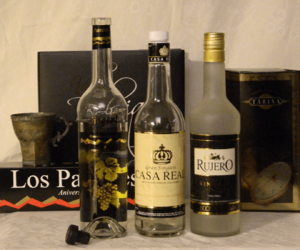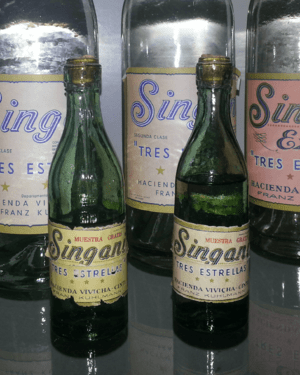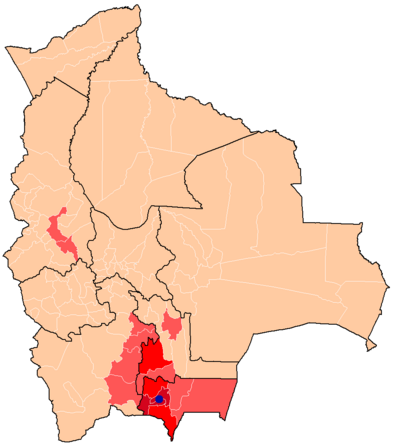Singani facts for kids
Singani is a special drink from Bolivia. It's a type of brandy made by distilling white Muscat of Alexandria grapes. Singani is only made in the high valleys of Bolivia. It is the country's national drink and an important part of its cultural heritage.
People have been making Singani since the 1500s, soon after the Spanish arrived in South America. Monks first made it because they needed sacramental wine for their ceremonies and also started distilling. Many believe the name "Singani" comes from an old village near where the drink was first made. The Bolivian government has officially recognized Singani as a "Domain of Origin" (DO) and a "Geographical Indication" (GI). This means it must come from a specific area.
Since the 1990s, Bolivian rules say that grapes for Singani must grow at least 1,600 meters (5,250 feet) high. This makes Singani known as an "altitude product." Most Singani is made from grapes grown around 1,800 meters (6,000 feet) above sea level.
Contents
What Does "Singani" Mean?
The word "Singani" likely comes from the native Aymara language. The original Aymara word was "siwingani," which means "the place where sedges grow." Sedges are grass-like plants found near rivers in Andean valleys. Over time, the word changed to "Singani."
There are several places in Bolivia with similar names. It's not clear which exact place first became famous for making Singani. However, these places were often old native settlements where missions were built. These missions started making wine and then liquor, which was traded to the big city of Potosí.
A Brief History of Singani
Grapes were brought to the Americas around 1520 by Spanish settlers. Two main types were muscat of alexandria and mission (grape). The Muscat of Alexandria grape is still used for Singani today.
Spanish explorers arrived in the Inca Empire in 1528. Soon after, religious groups also came. By 1538, Spanish cities were being built in what is now Bolivia. In 1545, a huge amount of silver was found nearby in Potosí. This made Potosí one of the largest and richest cities in the world. Because of this, many missions were set up in the area. These missions needed wine for religious services, so they started growing grapes. This led to the start of winemaking in Bolivia between the 1530s and 1550s. It's believed that the name "Singani" for this distilled spirit began in the late 1500s.
Most distilled drinks in the Spanish colonies were called "aguardiente." But in Bolivia, three things made people start calling their grape liquor "Singani":
- The huge market in Potosí.
- Other "aguardiente" drinks coming from Peru.
- The need for a clear trade name for their special grape liquor.
The first places where "Singani" was likely made stretch from Potosí to the old Spanish royal road. These areas include:
- Sivingani Canton in Mizque Province, which was an early mission and wine producer.
- A native village called Sivingani in Nor Cinti Province, which made wine and grape liquor by the 1550s.
- Areas like the T'uruchipa Valley and Santiago de Cotagaita, where Augustinian missions were active around 1550. These were close to Potosí, which bought a lot of Singani.
By 1585, the Cinti region became a major center for wine and Singani. People from Potosí even moved there to have children because Potosí was too cold and busy. This created a strong link between the Cinti wine region and the city of Potosí. Records from the 1500s show that Cinti sent wine and distilled liquor to Potosí. At that time, Potosí was a huge city, and people there drank a lot of wine, chicha, and other liquors.
In the 1600s, Bolivia's Tarija region started supplying fruit for Singani. By the 1900s, Tarija became the main supplier. Many Singani makers moved their businesses there. Today, most of Bolivia's grape, wine, and Singani industry is in Tarija. However, since 2000, there's been new interest in the original Cinti region, and some small producers are bringing back old brands.
Over time, Singani makers decided to use only one type of grape for their product. Rules were also made about the minimum altitude for vineyards.
Official Rules for Singani
Unlike a similar drink called pisco, which is made in two different countries, Singani has always been made only in Bolivia. There are no arguments about where it comes from. For over 400 years, Singani has been a special local product. In recent years, Bolivia has made laws to protect it. One reason was to make sure that unregulated homemade drinks could not be called Singani. Another reason was to keep control of the Singani name, learning from other drinks like tequila that can be bottled by foreign companies.
Bolivian laws state that Singani is a unique product of Bolivia. The word "Singani" cannot be used for anything else. Laws also set up the "Domain of Origin" (DO) and "Geographical Indication" (GI) for Singani, listing the specific areas where it can be made. Other laws control how Singani is made, including the rule that grapes must be grown at least 1,600 meters high. These rules also set standards for how pure Singani must be and how it should be labeled.
Because of international agreements, drinks like pisco, cachaça (from Brazil), and tequila (from Mexico) are recognized by the US government under their own names. However, there is no such agreement for Singani with the US. So, in the USA, Singani is sold as "brandy." But in Bolivia, Singani is not just the national drink; it's seen as a unique product and a cultural treasure.
The area where Singani is produced covers about 20,000 acres. Most Singani production since 1980 is in the Tarija regions of Arce, Avilés, and Méndez.
Several agencies help control and oversee Singani production:
- IBNORCA: Publishes the rules.
- SENASAG: Makes sure the rules are followed.
- CENAVIT: A national lab that studies and investigates.
- FAUTAPO: Helps with studies, education, and development of the grape, wine, and Singani industry.
Where Singani is Made
The official areas for growing grapes and making Singani include parts of four of Bolivia's nine Departments. Not all parts of these areas are suitable for growing grapes. Some areas are too steep, too cold, or too dry. So, vineyards are limited to specific towns and regions listed in the law.
The main areas where Singani is made are:
- La Paz Department (Bolivia): In Loayza Province and Pedro Domingo Murillo Province, specifically in Luribay and Sapahaqui.
- Chuquisaca Department: In Nor Cinti Province and Sud Cinti Province.
- Tarija Department: In José María Avilés Province, Eustaquio Méndez Province, and Aniceto Arce Province.
- Potosí Department: In Nor Chichas Province, Sud Chichas Province, Cornelio Saavedra Province, and José María Linares Province, specifically in Turuchipa, Cotagaita, Vicchoca, Tumusla, Poco Poco, Tirquibuco, and Oroncota.
How Singani is Made
Of all the grape types brought to the Americas by the Spanish, the Muscat of Alexandria grape was most valued for its strong smell. This grape is known for its intense natural aromas, especially when grown in the right conditions.
Qualities and Growing Areas
Singani grapes grow in the Andes mountains at very high elevations, from 5,250 to 9,200 feet above sea level. For example, some vineyards in Tarija are at 8,850 feet. Most large vineyards are around 6,000 feet high because it's easier to work there. Even though it's high, it rarely freezes at night. The surrounding mountains protect the vineyards from cold winds and hailstorms.
The air in the mountains is thin, cold, and dry, but the sun is very strong. Grapes grown here experience big temperature changes between day and night. Studies show that grapes in these conditions produce more of the good-smelling compounds. The soil is rich clay and sandy loam from mountain erosion. Water comes from melting snow and mountain rain. Because the land is steep, vineyards are often small plots, and grapes are usually picked by hand.
Unlike other grape spirits, Singani is made only from the Muscat of Alexandria grape. It is made in single batches and never mixed with other spirits. Because of the special methods used for centuries, the extreme high-altitude climate, and the mountain soil, Singani has a unique flavor. It gets its flavor without being aged in barrels, much like tequila.
The official qualities of Singani are:
- Look: Clear, clean, and bright.
- Color: Colorless.
- Smell: Strong smell of Muscat of Alexandria grapes.
- Taste: Smooth and balanced.
Singani does not contain sulfites, colors, or other additives found in some other spirits. It also isn't aged. Because of this, Singani is more like "eau-de-vie" (a clear fruit brandy) than regular brandy. Bolivian rules are very strict about Singani's purity. For example, it must have very low levels of copper, much lower than what is allowed in other countries' liquors.
Fermentation and Distillation
Grapevines are cared for all year, but grapes are picked only once a year. Grapes are carefully chosen by hand to make sure only the best ones are used. The grapes are fermented to make a "must," or raw wine, which is then distilled. Today, modern equipment like European stills and stainless steel tanks are used to keep the quality high. The stills are run carefully to capture Singani's unique character.
The goal of fermentation is to keep and improve the grape's natural aromas. The goal of distillation is to capture these aromas while removing unwanted substances. The final product must be perfect because it won't be aged or blended later. After distilling, the liquor is kept in clean containers for exactly 6 months. This allows the aroma to become stronger before bottling.
Aging Singani
Many aged liquors get their flavor from interacting with wood barrels. This creates flavors like vanilla. But in Singani, all the flavor must come from the grape itself and the fermentation process. Grapes with richer aromas are preferred. Makers who have tried aging Singani say that its special character becomes weaker, and it starts to taste like other aged liquors. Under current rules, such a drink could not be called Singani.
Purity and Potency
Like most liquors, Singani comes out of the still stronger than it is bottled. This is done to reduce unwanted substances. Singani makers are careful to keep bad substances out so that the grape's natural aroma is clear and not spoiled by off-odors.
Sometimes, people might say Singani is a "fiery brandy." This is usually because they are referring to unregulated homemade drinks. Real Singani has no harsh taste and must be smooth, according to its legal profile. As for strength, Singani is bottled at 80 proof, which means it has the same alcohol content as most other liquors.
Singani Makers and Brands
There are three main Singani makers, several medium-sized producers, and many small local operations. The three major companies supply Singani across the whole country. Medium producers usually cover a specific region, and small firms sell to very local markets.
- SAIV: A large company that makes Bolivia's Casa Real brand.
- Bodegas Kuhlmann: A family-owned business that makes Los Parrales and Tres Estrellas Singani.
- La Concepción: A public company that produces the Rujero brand.
These three companies make most of the Singani consumed in Bolivia.
Medium-level producers include SAGIC (San Pedro de Oro), Sociedad San Rafael (Sausini), Bodegas Kohlberg (La Cabana), Casa de Plata (Valluno), and Singani Ocho Estrellas.
Many Bolivian producers offer different levels of their brands, often using colors like black, red, or blue, similar to how Johnnie Walker whisky does. In 2004, the industry produced 4 million bottles of Singani. The amount produced depends on how many grapes are grown and how much suitable land is available. By 2010, there were between 12,000 and 13,000 acres of vineyards in Bolivia, used for table grapes, wine, and Singani.
International Awards
Since 2005, Singani producers, especially Bodegas Kuhlmann, have worked hard to enter international competitions. They focus on professional contests like the Concours Mondial de Bruxelles. This small industry has won nine gold and grand gold medals in international competitions over seven years.
How Singani is Used
Since the 1500s, Singani has often been drunk on its own. Cocktails became popular much later. Around 1608, miners in Potosí, where it was very cold, mixed hot milk with Singani and spices. They called this drink "sucumbé," and it's the oldest known Singani mixed drink.
Singani is very popular at national festivals, especially Saint John's Eve and the annual Virgen del Socavón carnival (Carnaval de Oruro). It's also the traditional drink at weddings, religious holidays, birthday parties, and other celebrations. A common activity is to play "cacho," a dice game similar to yahtzee, while drinking Singani.
Images for kids
See also
 In Spanish: Singani para niños
In Spanish: Singani para niños





